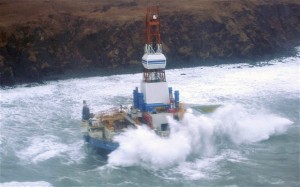Shell Runs Its Arctic Drilling Rig Aground; Coast Guard Prepares For 'Possible Spill-Response'
 It appears 2013 will begin much like 2012 ended for Shell’s Arctic Ocean drilling efforts – with yet another mishap.
It appears 2013 will begin much like 2012 ended for Shell’s Arctic Ocean drilling efforts – with yet another mishap.After several failed attempts to secure the equipment in harsh weather, Shell’s enormous Kulluk drilling rig ran aground near Kodiak Island, Alaska late Monday night. With approximately 143,000 gallons of fuel and 12,000 gallons of lubricating oil and hydraulic fluid on board, the Coast Guard is now preparing for the “salvage and possible spill-response phase of this event.” Two Coast Guard flyovers on Tuesday did not detect any leakage but a severe winter storm – with winds up to 70 mph and waves as high as 50 feet – has prevented crews from conducting a full assessment of the damage.
After an initial exploratory drilling season plagued with technical failures, struggles with Mother Nature, and numerous warnings about the lack of preparedness to operate in the region, the oil company’s woes have only continued. In November, the challenging and unpredictable Arctic conditions created a logistical nightmare as Shell struggled to get the Kulluk out of the Beaufort Sea as winter sea ice encroached.
As the Anchorage Daily News reports, the rig was headed to Seattle for maintenance last week when a mechanical failure in the tow vessel halted its progress and left “crews struggling against worsening weather and a mobile drilling unit that was unmanned with no propulsion capability of its own.” Huge winds and fierce swells thwarted numerous attempts to reattach tow lines and bring the rig to safety. Once grounding appeared inevitable, crews worked to steer the vessel to an area where it would have the least environmental impact.
Fortunately for Shell, this latest incident occurred in close proximity to the Coast Guard station in Kodiak, which enabled the helicopter rescue of 18 crew members on Saturday in extremely challenging conditions. The station also happens to be the closest permanent Coast Guard facility to where the oil company intends to use the Kulluk when they resume drilling this summer – over 1,000 miles away or 3 to 4 hours by plane in ideal conditions.
Like each of the incidents before it, the ongoing crisis with the Kulluk underscores the numerous challenges presented by operating in the Arctic, as well as the industry’s lack of preparedness to anticipate and overcome them. Drilling for oil in the Arctic Ocean carries an enormous amount of risk – a fact pointed out not just by environmentalists but a major insurance company, bank, legislative body, and even a fellow oil major among others.
As Rep. Ed Markey (D-MA) emphasized in a statement released Tuesday, “Oil companies keep saying they can conquer the Arctic, but the Arctic keeps disagreeing with the oil companies … Drilling expansion could prove disastrous for this sensitive environment.”
Problems with logistics, infrastructure, and scientific knowledge only add to a bigger problem: that the Arctic is already being battered by accelerating climate change. In the summer of 2012, the region lost a mass of ice the size of Canada and Texas combined.
Shell’s Arctic endeavor has been riddled with problems from the outset. As the company looks toward a full drilling season in 2013, there are far more questions than answers and far more mishaps than successes.
You can return to the main Market News page, or press the Back button on your browser.

